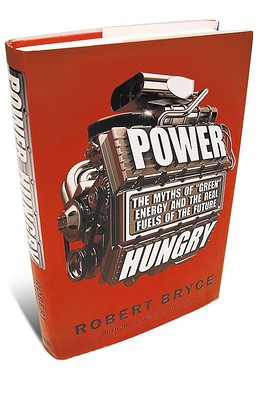
Source of book image: online version of the WSJ review quoted and cited below.
(p. A15) So you want to build a wind farm? OK, Mr. Bryce says, to start you’ll need 45 times the land mass of a nuclear power station to produce a comparable amount of power; and because you are in the middle of nowhere you’ll also need hundreds of miles of high-voltage lines to get the energy to your customers. This “energy sprawl” of giant turbines and pylons will require far greater amounts of concrete and steel than conventional power plants–figure on anywhere from 870 to 956 cubic feet of concrete per megawatt of electricity and 460 tons of steel (32 times more concrete and 139 times as much steel as a gas-fired plant).
Once you’ve carpeted your tract of wilderness with turbines and gotten over any guilt you might feel about the thousands of birds you’re about to kill, prepare to be underwhelmed and underpowered. Look at Texas, Mr. Bryce says: It ranks sixth in the world in total wind-power production capacity, and it has been hailed as a model for renewable energy and green jobs by Republicans and Democrats alike. And yet, according to the Electric Reliability Council of Texas, which runs the state’s electricity grid, just “8.7 percent of the installed wind capability can be counted on as dependable capacity during the peak demand period.” The wind may blow in Texas, but, sadly, it doesn’t blow much when it is most needed–in summer. The net result is that just 1% of the state’s reliable energy needs comes from wind.
For the full review, see
TREVOR BUTTERWORTH. “BOOKSHELF; The Wrong Way To Get to Green; Once you’ve carpeted the wilderness with wind-farm turbines, and crushed any guilt about the birds you’re about to kill, prepare to be underwhelmed and underpowered.” The Wall Street Journal (Tues., APRIL 27, 2010): A15.
(Note: the online version of the article is dated APRIL 30, 2010.)
The book under review is:
Bryce, Robert. Power Hungry; the Myths of “Green” Energy and the Real Fuels of the Future. New York: PublicAffairs, 2010.
